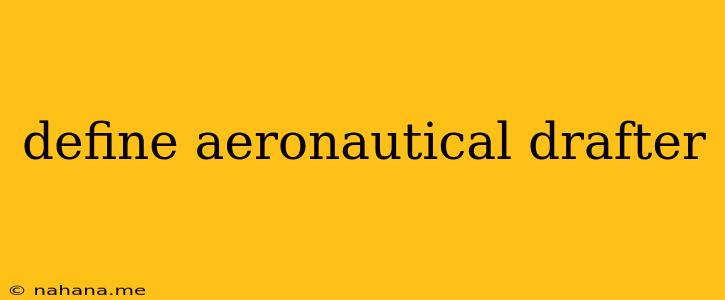An Aeronautical Drafter is a specialized type of drafter who focuses on creating technical drawings and blueprints for aircraft and aerospace components. They play a crucial role in the design and development of aircraft, spacecraft, and other aerospace vehicles.
Responsibilities of an Aeronautical Drafter:
- Creating detailed technical drawings: They use computer-aided design (CAD) software to create accurate and precise drawings that depict every aspect of an aircraft or aerospace component. These drawings include dimensions, materials, tolerances, and other critical information for manufacturing and assembly.
- Developing specifications: Aeronautical drafters work closely with engineers to understand design requirements and translate them into detailed drawings and specifications. They ensure that the drawings adhere to industry standards and meet the specific needs of the project.
- Collaborating with engineers and other professionals: They work in teams with engineers, designers, and other professionals to ensure that the drawings accurately reflect the design intent. They may also provide technical support and answer questions regarding the drawings.
- Staying up-to-date on industry trends and technologies: The aerospace industry is constantly evolving, so aeronautical drafters need to keep abreast of new materials, manufacturing processes, and design techniques. They may attend training courses or seminars to stay current.
- Creating 3D models: Using 3D CAD software, they can create realistic models of aircraft and components, allowing engineers and designers to visualize the design from all angles.
- Developing technical documentation: They create technical manuals, assembly instructions, and other documents that provide clear and concise information about the aircraft or component.
- Checking and verifying drawings: They ensure that the drawings are accurate, complete, and meet all relevant standards. They may also perform quality control checks on drawings created by other drafters.
Skills and Qualifications:
- Technical drawing skills: Proficiency in CAD software like AutoCAD, SolidWorks, or CATIA is essential.
- Knowledge of aerospace engineering principles: Understanding basic aerodynamic principles, structural design, and materials science is crucial.
- Attention to detail: Aeronautical drafters must be meticulous in their work, as even small errors in drawings can have significant consequences.
- Communication skills: They need to communicate effectively with engineers, designers, and other professionals to ensure that the drawings accurately reflect the design intent.
- Problem-solving skills: They may encounter technical challenges and need to find solutions to ensure the accuracy and effectiveness of the drawings.
Career Path:
Aeronautical drafters can progress in their careers through experience and education. They may become senior drafters, lead drafters, or even technical specialists in specific areas of aerospace design. With further education, they can pursue engineering degrees or specialized roles in aircraft design and development.
